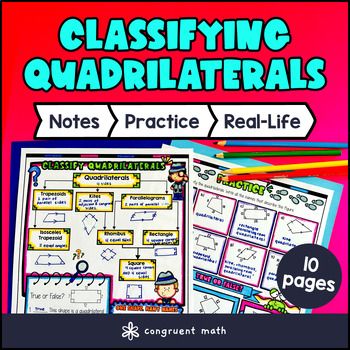Want more ideas and freebies?
Get my free resource library with digital & print activities—plus tips over email.
Join for Free Resources →
$4.25
Ever wondered how to teach quadrilaterals classification in an engaging way to your fifth-grade students? Thinking of how to engaging lesson on classifying trapezoids, parallelograms, kites, rectangles, squares and rhombus?
In this lesson plan, students will learn about classifying quadrilaterals and their real-life applications. Through artistic, interactive guided notes, checks for understanding, practice coloring worksheet, and a maze activity, students will gain a comprehensive understanding of quadrilateral properties.
The lesson ends with a real-life example that explores how recognizing different types of quadrilaterals can help in identifying and designing various objects in our surroundings.

$4.25
After this lesson, students will be able to:
Before this lesson, students should be familiar with:
As a hook, ask students why it is important to classify shapes in real life. Refer to the last page of the guided notes for real-life applications of classifying quadrilaterals, such as in architecture and design. Additionally, review the FAQs below for more ideas on how to engage students in this topic.
Use the first page of the guided notes to introduce the concept of classifying quadrilaterals. Walk through the hierarchy of shapes, including trapezoids, parallelograms, kites, isosceles trapezoids, rhombuses, rectangles, and squares. Highlight key properties that distinguish each type of quadrilateral and use the flow chart (pg. 1 of guided notes) to explain that attributes belonging to a category of two-dimensional figures also belong to all subcategories of that category.
Continue with the second page of the guided notes to give more examples of classifying quadrilaterals based on the properties. Encourage students work in pairs, small groups, or individual to identify these shapes.
Based on student responses during the introduction, reteach any concepts that students may find challenging. If needed, consider pulling out students for additional support while more advanced students begin working on the practice exercises.
Have students practice classifying quadrilaterals using the practice problem set worksheet (pg. 2 of guided notes) provided in the resource. Then, have them work on the maze activity (pg. 3 of guided notes) for fun practice. Walk around to answer student questions.
Fast finishers can start the color by number activity included in the resource (pg. 4 of guided notes) for extra practice. You can also assign it as homework for the remainder of the class.
Using the last page of the guided notes, bring the class back together, and introduce the concept of real-world applications of quadrilaterals. Discuss how knowledge of different types of quadrilaterals, such as parallelograms, rectangles, and squares, is used in architecture and construction to design buildings, rooms, and furniture. Students can explore how these shapes are utilized in creating blueprints, floor plans, and measuring angles for symmetry and stability in various structures. Refer to the FAQ for more ideas on how to teach real-life applications of quadrilaterals!
If you’re looking for digital practice for Classify Quadrilaterals, try my Pixel Art activities in Google Sheets. Every answer is automatically checked, and correct answers unlock parts of a mystery picture. It’s incredibly fun, and a powerful tool for differentiation.
Here is 1 activity to explore:
A fun, no-prep way to practice Classify Quadrilaterals is Doodle Math — they’re a fresh take on color by number or color by code. It includes multiple levels levels of practice, perfect for a review day or sub plan.
Here is 1 activity to try:
Quadrilaterals are classified into various types based on their properties:
To determine if a quadrilateral is a parallelogram:
A rectangle and a square are different because:
To identify a rhombus among quadrilaterals:
The defining property of a trapezoid is having:
To differentiate a kite from other quadrilaterals:
Quadrilaterals are classified based on properties to:
Identifying quadrilaterals is helpful in real life because it allows us to recognize and work with different shapes in construction, design, and everyday objects, ensuring stability and proper fit. For example, knowing the properties of rectangles helps in building furnitures and creating blueprints in design.
Get my free resource library with digital & print activities—plus tips over email.
Join for Free Resources →